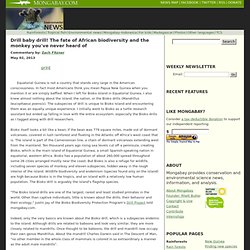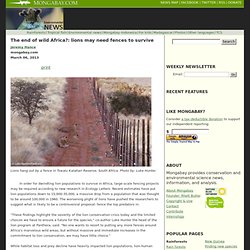

Here is my manifesto for rewilding the world. Until modern humans arrived, every continent except Antarctica possessed a megafauna.

In the Americas, alongside mastodons, mammoths, four-tusked and spiral-tusked elephants, there was a beaver the size of a black bear: eight feet from nose to tail. There were giant bison weighing two tonnes, which carried horns seven feet across. The short-faced bear stood 13ft in its hind socks. One hypothesis maintains that its astonishing size and shocking armoury of teeth and claws are the hallmarks of a specialist scavenger: it specialised in driving giant lions and sabretooth cats off their prey. The Argentine roc (Argentavis magnificens) had a wingspan of 26ft. During the previous interglacial period, Britain and Europe contained much of the megafauna we now associate with the tropics: forest elephants, rhinos, hippos, lions and hyenas.
Most of the deciduous trees in Europe can resprout wherever the trunk is broken. All this has been forgotten, even by professional ecologists. Bernie Krause: The voice of the natural world. Bernie Krause continues to make history by capturing the fading voices of nature: studying sonic interplay between species as they attract mates, hunt prey, and sound out their roles in the ecosystem.

Krause’s recordings are not merely travelogues or relaxation tools -- they are critical barometers of global environmental health. His documents of vanishing aural habitats are a chilling reminder of shrinking biodiversity. As he tells the Guardian: "The fragile weave of natural sound is being torn apart by our seemingly boundless need to conquer the environment rather than to find a way to abide in consonance with it. " His website is Wild Sanctuary Source: TED Talk. Drill baby drill! The fate of African biodiversity and the monkey you've never heard of. Equatorial Guinea is not a country that stands very large in the American consciousness.

In fact most Americans think you mean Papua New Guinea when you mention it or are simply baffled. When I left for Bioko Island in Equatorial Guinea, I also knew almost nothing about the island, the nation, or the Bioko drills (Mandrillus leucophaeus poensis). The subspecies of drill is unique to Bioko Island and encountering them was an equally unique experience.
I initially went to Bioko as a turtle research assistant but ended up falling in love with the entire ecosystem, especially the Bioko drills as I tagged along with drill researchers. Bioko itself looks a bit like a bean; if the bean was 779 square miles, made out of dormant volcanoes, covered in lush rainforest and floating in the Atlantic off Africa's west coast that is. "The Bioko Island drills are one of the largest, rarest and least studied primates in the world. A Bioko drill (Mandrillus leucophaeus poensis). However there's hope. Featured video: If I were a panda... The end of wild Africa?: lions may need fences to survive. Lions hang out by a fence in Tswalu Kalahari Reserve, South Africa.

Photo by: Luke Hunter. In order for dwindling lion populations to survive in Africa, large-scale fencing projects may be required according to new research in Ecology Letters. Recent estimates have put lion populations down to 15,000-35,000, a massive drop from a population that was thought to be around 100,000 in 1960. Into the unknown mountains of Cambodia: rare birds, rice wine, and talk of tigers. Howie Nielsen on a trek earlier this year into a remote portion of Virachey National Park.

Photo by: Greg McCann. Ringed with forested mountains forming the borders with Laos and Vietnam, the northeast corner of Cambodia has been an intriguing blank spot among my extensive travels through the country. Nestled up against this frontier is Virachey National Park, created in 1993. I began searching for a way to explore this area a couple of years ago, hoping to connect with conservation NGOs to get me into the park; no one seemed to know much about it. I learned that the area had been written off by these groups due to massive land concessions given to logging and rubber concerns.
The only attempt at a biological assessment came in October 2007, when Conservation International helicoptered 10 researchers into the park for a 2 week stay. This trek came to be as a result of an 8-month email relationship with Greg McCann (see Greg's note at bottom).